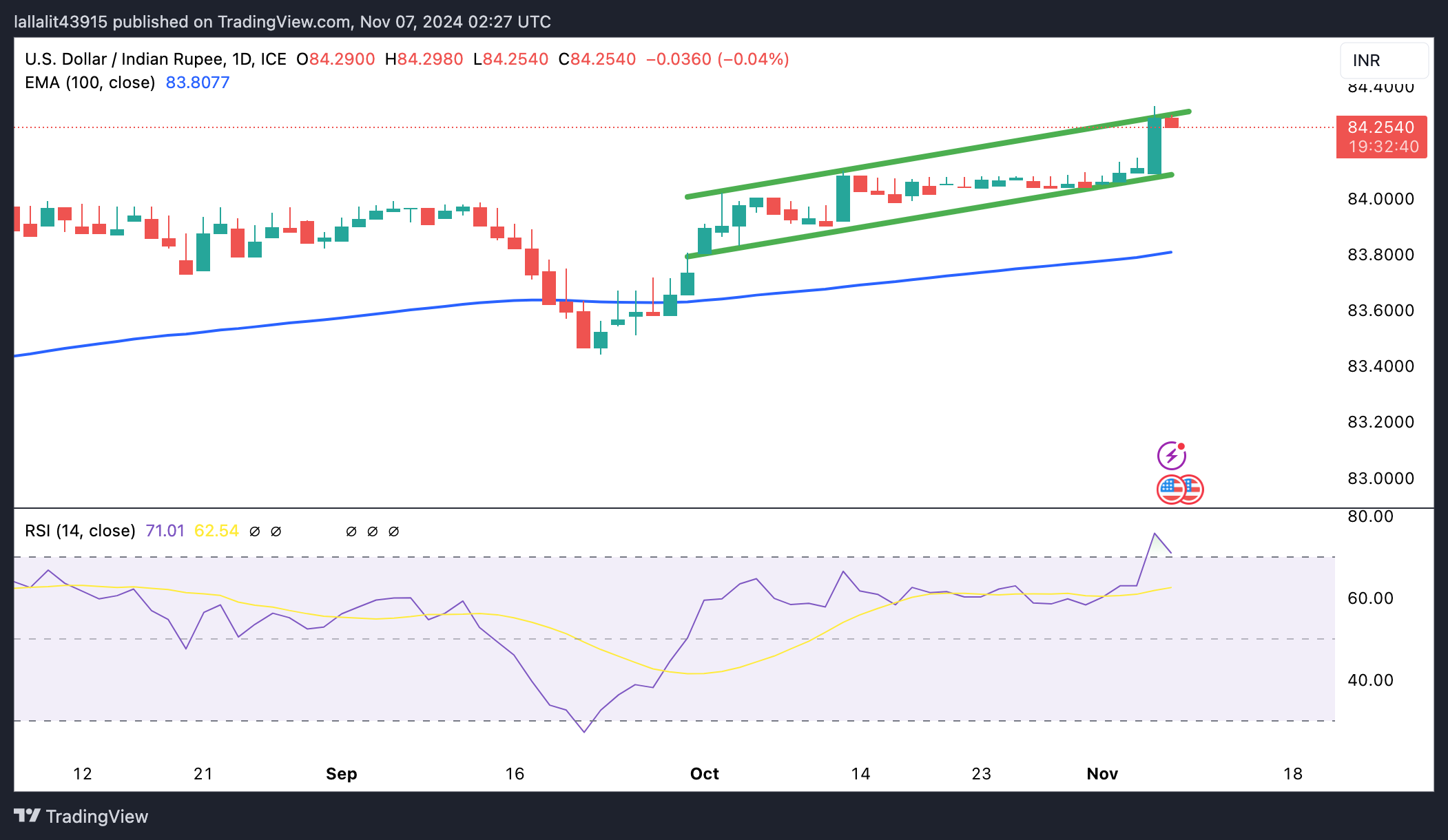USD/INR gathers strength as equity outflows drag Indian Rupee to fresh low
- The Indian Rupee trends lower in Friday’s Asian session.
- The Indian equity selloff and the rise in crude oil prices continue to undermine the INR.
- The advanced US November Michigan Consumer Sentiment data and Fed Bowman’s speech will be the highlights on Friday.
The Indian Rupee (INR) weakens on Friday. The local currency depreciated to record lows again in the previous session amid weak domestic equities and sustained foreign fund outflows. Additionally, the rise in crude oil prices also weighed on the INR.
Donald Trump is expected to boost the US Dollar (USD) and push US yields higher, driven by anticipated populist measures that could increase borrowing, inflation, and yields. This, in turn, might contribute to the INR’s downside. However, the downward movement of the local currency might be limited as the Reserve Bank of India (RBI) is likely to intervene in the market by selling the USD to avoid excess volatility.
Looking ahead, traders will keep an eye on the advanced US Michigan Consumer Sentiment data for November. Also, the Federal Reserve’s (Fed) Michelle Bowman is scheduled to speak later on Friday.
Daily Digest Market Movers: Indian Rupee remains sensitive to global factors
- Foreign investors have pulled out more than $1.5 billion from local stocks so far in November, adding to $11 billion of outflows in the previous month.
- India appears to be in a comparatively stronger position than many of its Asian peers, owing to its lower dependency on trade with China, according to a report by Emkay.
- The Federal Open Market Committee (FOMC) lowered its benchmark overnight borrowing rate by 25 basis points (bps) to a target range of 4.50%-4.75% at its November meeting on Thursday.
- Fed Chair Jerome Powell said the US central bank is pursuing interest rate cuts, while monetary policy remains tight. Powell further stated that the Fed will continue assessing data to determine the "pace and destination" of interest rates as inflation has slowed nearing the Fed’s 2% target.
- According to the CME FedWatch Tool, the possibility of a quarter-point December rate reduction rose to more than 68% following the Fed meeting, while the odds of a pause declined to nearly 32%.
- The US Initial Jobless Claims for the week ending October 25 increased to 221K, the US Department of Labor (DoL) showed Thursday. This figure matched initial estimates and was higher than the previous reading of 218K (revised from 216K).
Technical Analysis: USD/INR’s broader trends remain constructive
The Indian Rupee trades softer on the day. According to the daily chart, the USD/INR pair remains in a bullish trend as the price holds above the key 100-day Exponential Moving Average (EMA). Nonetheless, the 14-day Relative Strength Index (RSI) is over the midline near 75.0, suggesting an overbought condition. This means that additional consolidation should not be ruled out before positioning for any short-term USD/INR appreciation.
A move above the upper boundary of the ascending trend channel at 84.30 could pave the way for the next hurdle at 84.50, followed by the 85.00 psychological level.
On the other hand, a breach of the lower limit of the trend channel and the high of October 11 at the 84.05-84.10 region could draw in selling pressure to 83.82, the 100-day EMA. Further south, the next contention level is seen at 83.46, the low of September 24.

Indian Rupee FAQs
The Indian Rupee (INR) is one of the most sensitive currencies to external factors. The price of Crude Oil (the country is highly dependent on imported Oil), the value of the US Dollar – most trade is conducted in USD – and the level of foreign investment, are all influential. Direct intervention by the Reserve Bank of India (RBI) in FX markets to keep the exchange rate stable, as well as the level of interest rates set by the RBI, are further major influencing factors on the Rupee.
The Reserve Bank of India (RBI) actively intervenes in forex markets to maintain a stable exchange rate, to help facilitate trade. In addition, the RBI tries to maintain the inflation rate at its 4% target by adjusting interest rates. Higher interest rates usually strengthen the Rupee. This is due to the role of the ‘carry trade’ in which investors borrow in countries with lower interest rates so as to place their money in countries’ offering relatively higher interest rates and profit from the difference.
Macroeconomic factors that influence the value of the Rupee include inflation, interest rates, the economic growth rate (GDP), the balance of trade, and inflows from foreign investment. A higher growth rate can lead to more overseas investment, pushing up demand for the Rupee. A less negative balance of trade will eventually lead to a stronger Rupee. Higher interest rates, especially real rates (interest rates less inflation) are also positive for the Rupee. A risk-on environment can lead to greater inflows of Foreign Direct and Indirect Investment (FDI and FII), which also benefit the Rupee.
Higher inflation, particularly, if it is comparatively higher than India’s peers, is generally negative for the currency as it reflects devaluation through oversupply. Inflation also increases the cost of exports, leading to more Rupees being sold to purchase foreign imports, which is Rupee-negative. At the same time, higher inflation usually leads to the Reserve Bank of India (RBI) raising interest rates and this can be positive for the Rupee, due to increased demand from international investors. The opposite effect is true of lower inflation.



